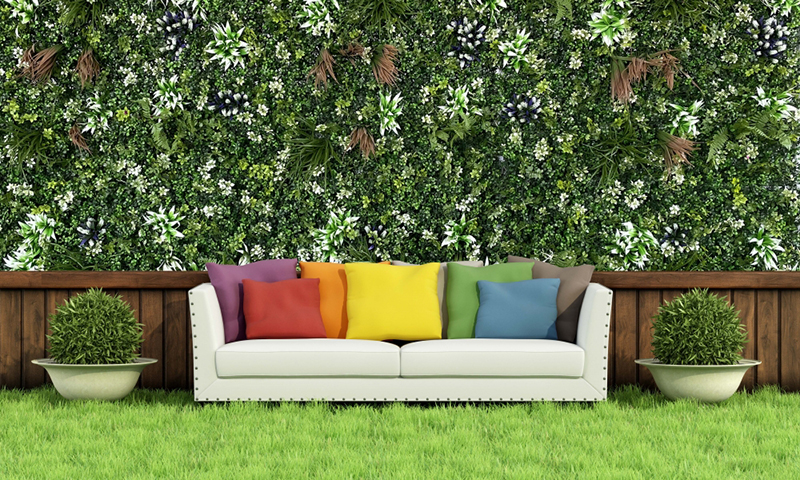Future Trends in the Development of 3D Artificial Vertical Gardens
The integration of 3D artificial vertical gardens into urban landscapes is poised to accelerate, driven by technological innovation, sustainability demands, and evolving architectural practices. These structures are transitioning from decorative elements to multifunctional ecosystems that address climate resilience, biodiversity loss, and human well-being. Below are key trends shaping their trajectory.

Smart Technology Integration for Enhanced Efficiency
The rise of the Internet of Things (IoT) and artificial intelligence (AI) is transforming vertical gardens into intelligent systems. Embedded sensors will continuously monitor environmental factors like soil moisture, light levels, and air quality, transmitting data to cloud-based platforms. AI algorithms will analyze this information to optimize irrigation schedules, nutrient delivery, and plant health diagnostics, minimizing human intervention and resource waste. For instance, machine learning models could predict pest outbreaks by detecting subtle changes in plant behavior, enabling preemptive organic treatments.
Dynamic lighting solutions will also play a role. LED systems with adjustable spectra will mimic natural sunlight cycles, supporting photosynthesis in low-light urban environments. Some prototypes already use solar-powered panels to harvest energy during the day, storing it for nighttime operation. This autonomy reduces reliance on grid electricity, aligning with global decarbonization goals.
Additionally, augmented reality (AR) interfaces may allow users to visualize garden growth patterns or experiment with plant arrangements before physical installation. These tools could democratize design, enabling non-experts to create biodiverse, aesthetically pleasing vertical spaces.
Biophilic Design and Human-Centric Innovation
As biophilic design gains traction, vertical gardens will increasingly prioritize human health benefits. Research indicates that proximity to greenery reduces stress, improves concentration, and accelerates recovery from illness. Future gardens will incorporate sensory-rich elements like fragrant herbs, textured foliage, and edible plants to engage multiple senses. Interactive features, such as touch-sensitive vines or sound-absorbing moss panels, could further enhance mental well-being in noisy, high-density cities.
Accessibility will also improve. Modular 3D designs will allow customization for diverse spaces, from residential balconies to corporate lobbies. Lightweight, foldable substrates will enable temporary installations at events or disaster zones, providing instant green relief. Some projects may even integrate vertical gardens into public transportation hubs, improving air quality for daily commuters.
Collaborations between architects, biologists, and psychologists will drive innovation. For example, gardens could be tailored to support specific demographics, such as dementia patients in healthcare facilities, using calming color palettes and familiar plant species.
Sustainable Materials and Circular Economy Practices
The push for sustainability will reshape material choices in vertical garden construction. Biodegradable polymers derived from agricultural waste or algae will replace traditional plastics, reducing microplastic pollution. Mycelium-based substrates, grown from fungal networks, offer a renewable alternative to peat moss, which is often harvested unsustainably. These materials not only decompose naturally but also enhance soil fertility over time.
Water management will become more efficient through closed-loop systems. Graywater from buildings could be filtered through plant roots and recycled for non-potable uses, cutting freshwater demand. Some designs may incorporate atmospheric water generators to harvest moisture from humid air, particularly in arid regions.
The circular economy will influence end-of-life planning. Modular components will be designed for disassembly, allowing easy replacement or repurposing of damaged parts. At the end of their lifespan, materials like coconut coir or rice husks could be composted or used as animal bedding, ensuring zero waste.
Climate Resilience and Ecosystem Restoration
As climate change intensifies, vertical gardens will serve as adaptive tools for urban heat mitigation and flood control. High-albedo surfaces coated with reflective materials will reduce heat absorption, while dense foliage lowers ambient temperatures through evapotranspiration. In flood-prone areas, gardens with water-retentive substrates could absorb excess rainfall, alleviating pressure on drainage systems.
Biodiversity conservation will be another focus. Vertical gardens will act as “stepping stones” for wildlife, connecting fragmented habitats in cities. Native plant species will dominate designs, providing food and shelter for pollinators like bees and butterflies. Some projects may even reintroduce rare or endangered flora, creating gene banks for ecological restoration.
Collaborative initiatives between governments and private sectors could scale up these efforts. For example, city-wide mandates might require new buildings to allocate a percentage of facade space to vertical gardens, creating corridors for species movement.
Conclusion: A Greener Urban Future
The evolution of 3D artificial vertical gardens reflects a broader shift toward regenerative design, where human-made structures coexist with natural processes. By merging cutting-edge technology with ecological principles, these gardens offer scalable solutions to pressing global challenges. As research progresses and public awareness grows, their role in creating sustainable, livable cities will only expand, proving that innovation and nature can thrive in tandem.
Contact: Amy
Phone: 86-15311787313
E-mail: info@foszmac.com
Whatsapp:86-15311787313
Add: Fengtai District, Dacheng Road, No.24 Building, Room 203, Beijing, China